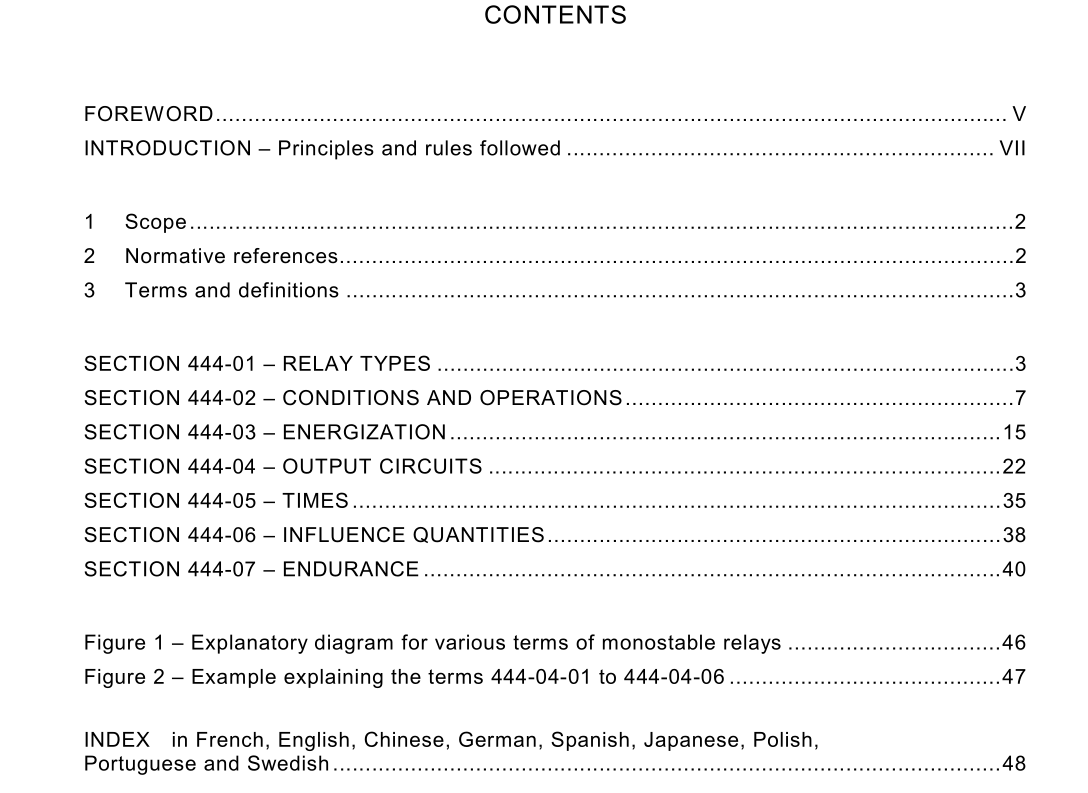IEC 60050-444 pdf download

IEC 60050-444 pdf download.International Electrotechnical Vocabulary
1 Scope
In the past, IEC 60050-446 (Part 446 of the IEV) listed the terminology for all types of electrical relays. In order to improve the precision of terms and definitions as well as the general visibility of relay terminology, it had been decided to split that part of the IEV into three separate parts optimised for the specific relay types covered. Therefore, this part of IEC 60050 gives terms and definitions for elementary relays (non- specified time all-or-nothing relays) superseding the terminology of IEC 60050-446 for such relays. The terminology for time relays is contained in IEC 60050-445 established in parallel with this part. A new part for measuring relays and protection equipment (IEC 60050-447) is also under preparation. When all these three parts are published, IEC 60050-446 shall be withdrawn from the IEV.
2 Normative references
The following normative documents contain provisions which, through reference in this text, constitute provisions of this International Standard. For dated references, subsequent amendments to, or revisions of, any of these publications do not apply. However, parties to agreements based on this International Standard are encouraged to investigate the possibility of applying the most recent editions of the normative documents indicated below. For undated references, the latest edition of the normative document referred to applies. Members of IEC and ISO maintain registers of currently valid International Standards. IEC 60947-1:1999, Low voltage switchgear controlgear – Part 1: General rules IEC 60050-441:1984, International Electrotechnical Vocabulary – Part 441: Switchgear, controlgear, fuses
3 Terms and definitions
NOTE 1 – In this part the simplified term “relay” is used instead of “elementary (non-specified-time all- or-nothing) relay”, except when ambiguity may occur. NOTE 2 – Although this part bears the title ELEMENTARY RELAYS some terms contain the addition “(for elementary relays)”. This is the case when the term has been defined differently in other parts of the IEV. NOTE 3 – Additional terms, concerning isolation, are defined in IEC 60664-1. NOTE 4 – The terms and definitions for time relays and measuring relays are contained in Parts 445 and 447 respectively.
electrical quantity which, when applied to the input circuit of an elementary relay under specified conditions, enables it to fulfill its purpose NOTE – For elementary relays the energizing quantity is usually a voltage. Therefore, the input voltage as energizing quantity is used in the definitions given below. Where a relay is energized by a given current instead, the respective terms and definitions apply with “current” used instead of “voltage”.value of the input voltage at which an electromagnetic relay attains a defined magnetic condition NOTE 1 – For polarized relays, distinction is made between preconditioning in forward (operate) direction, and preconditioning in reverse direction. NOTE 2 – For bistable relays, preconditioning may also be used to put the relay into a defined position.output circuit which, when the relay is in its operate condition, is either opened by a contact or is effectively non-conducting, and when the relay is in its release condition, is either closed by a contact or is effectively conducting
The preferred term is the term that heads a terminological entry; it may be followed by synonyms. It is printed in boldface. Synonyms: The synonyms are printed on separate lines under the preferred term: they are also printed in boldface, excepted for deprecated synonyms, which are printed in lightface, and followed by the attribute “(deprecated)”. Parts that may be omitted: Some parts of a term may be omitted, either in the field under consideration or in an appropriate context. Such parts are printed in boldface type, and placed in parentheses: Example: (electromagnetic) emission









